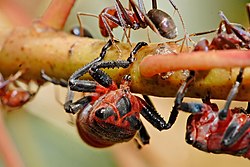Sap

Sap is a fluid transported in the xylem cells (vessel elements or tracheids) or phloem sieve tube elements of a plant. These cells transport water and nutrients throughout the plant.
Sap is distinct from
Insect honeydew is called sap, particularly when it falls from trees, but is only the remains of eaten sap and other plant parts.[1]
Types of sap
Saps may be broadly divided into two types: xylem sap and phloem sap.
Xylem sap
Xylem sap (pronounced
Over the past century, there has been some controversy regarding the mechanism of xylem sap transport; today, most plant scientists agree that the
Xylem sap transport can be disrupted by cavitation—an "abrupt phase change [of water] from liquid to vapor"[5]—resulting in air-filled xylem conduits. In addition to being a fundamental physical limit on tree height, two environmental stresses can disrupt xylem transport by cavitation: increasingly negative xylem pressures associated with water stress, and freeze-thaw cycles in temperate climates.[5]
Phloem sap
Phloem sap (pronounced

Many insects of the
Human uses
In some countries (e.g.,
Certain palm tree sap can be used to make
See also
References
- ^ "How to Remove Tree Sap From a Car". HowStuffWorks. 20 August 2019. Retrieved 23 December 2020.
- ISBN 978-3-642-68887-4.
- PMID 12060254.
- .
- ^ JSTOR 1939633. Archived from the original(PDF) on 2017-08-10. Retrieved 2018-12-18.
- PMID 37108078.
- ^ a b
Turgeon, Robert; Wolf, Shmuel (2009). "Phloem Transport: Cellular Pathways and Molecular Trafficking". Annual Review of Plant Biology. 60 (1): 207–21. PMID 19025382.
- ^ a b c
Douglas, A.E. (2006). "Phloem-sap feeding by animals: problems and solutions". Journal of Experimental Botany. 57 (4): 747–754. PMID 16449374.
- ^ Saupe, Stephen. "Plant Physiology". College of Saint Benedict and Saint John's University. Retrieved 3 April 2018.
- ^ Morselli, Mariafranca; Whalen, M Lynn (1996). "Appendix 2: Maple Chemistry and Quality". In Koelling, Melvin R; Heiligmann, Randall B (eds.). North American Maple Syrup Producers Manual. Bulletin. Vol. 856. Ohio State University. Archived from the original on 29 April 2006. Retrieved 20 September 2010.
- ISBN 978-1-4020-4992-7. Archivedfrom the original on 23 November 2017. Retrieved 6 April 2013.
External links
 Media related to Plant sap at Wikimedia Commons
Media related to Plant sap at Wikimedia Commons
